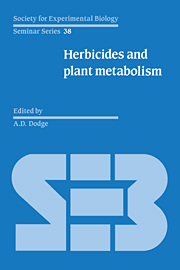Book contents
- Frontmatter
- Contents
- Contributors
- Preface
- Herbicide use and invention
- Herbicides interacting with photosystem II
- Herbicides interacting with photosystem I
- Carotenoids and chlorophylls: herbicidal inhibition of pigment biosynthesis
- Herbicides inhibiting lipid synthesis
- The shikimate pathway as a target for herbicides
- Herbicides that inhibit the biosynthesis of branched chain amino acids
- Glutamine synthetase and its inhibition
- Metabolism of herbicides – detoxification as a basis of selectivity
- Bioactivated herbicides
- Mechanisms involved in the evolution of herbicide resistance in weeds
- Conferring herbicide resistance on susceptible crops
- Herbicide glossary
- Herbicide index
- General index
Herbicides interacting with photosystem II
Published online by Cambridge University Press: 04 August 2010
- Frontmatter
- Contents
- Contributors
- Preface
- Herbicide use and invention
- Herbicides interacting with photosystem II
- Herbicides interacting with photosystem I
- Carotenoids and chlorophylls: herbicidal inhibition of pigment biosynthesis
- Herbicides inhibiting lipid synthesis
- The shikimate pathway as a target for herbicides
- Herbicides that inhibit the biosynthesis of branched chain amino acids
- Glutamine synthetase and its inhibition
- Metabolism of herbicides – detoxification as a basis of selectivity
- Bioactivated herbicides
- Mechanisms involved in the evolution of herbicide resistance in weeds
- Conferring herbicide resistance on susceptible crops
- Herbicide glossary
- Herbicide index
- General index
Summary
Introduction
Weed control using organic chemicals commenced just over half a century ago, when in 1932, 4,6-dinitro-o-cresol (DNOC) was first used as a weed-controlling agent. The phenoxyacetic acids such as 2,4-D followed in the 1940s. Chemical weed control was widely accepted when the ureas (1951), the triazines (1955) and the bipyridiniums (1960) became available. The latter three groups of herbicides act via the photosynthetic process. The ureas and triazines effectively block photosynthetic electron transport at the level of the Photosystem II acceptor site. Many reviews are now available on the effects of herbicides on Photosystem II, for example: Van Rensen (1982), Pfister & Urbach (1983), Sandmann & Böger (1986) and Renger (1986).
Research on the action of herbicides inhibiting photosynthesis has yielded much detailed information about their mechanisms of action. Furthermore, our understanding of the photosynthetic process has been greatly enhanced by the use of these chemicals as specific inhibitors. This chapter highlights important events of the research on Photosystem II herbicides and surveys some recent developments.
The photosynthetic electron transport pathway
The light energy conversion processes of photosynthesis are located in the grana of the chloroplasts, while the reduction of carbon dioxide occurs within the stroma. Grana consist of stacks of thylakoids, i.e. vesicle-like structures having an internal space surrounded by a membrane. The grana are interconnected by unappressed stroma thylakoids. The thylakoid membranes contain the electron and proton translocating components (Fig. 1).
- Type
- Chapter
- Information
- Herbicides and Plant Metabolism , pp. 21 - 36Publisher: Cambridge University PressPrint publication year: 1990
- 6
- Cited by

